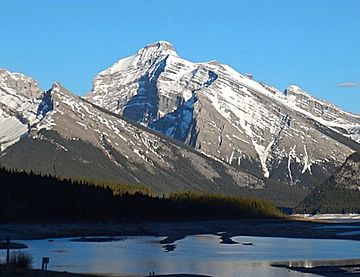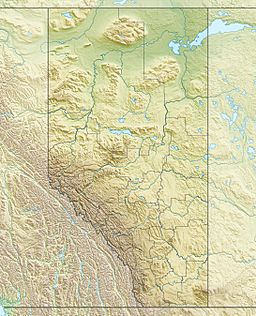Mount Sparrowhawk facts for kids
Quick facts for kids Mount Sparrowhawk |
|
|---|---|

Mount Sparrowhawk seen from Spray Lakes
|
|
| Highest point | |
| Elevation | 3,121 m (10,240 ft) |
| Prominence | 256 m (840 ft) |
| Parent peak | Mount Bogart (3144 m) |
| Listing | Mountains of Alberta |
| Geography | |
| Location | Alberta, Canada |
| Parent range | Kananaskis Range Canadian Rockies |
| Topo map | NTS 82J/14 |
| Geology | |
| Age of rock | Cambrian |
| Type of rock | Limestone |
| Climbing | |
| First ascent | 1947 by R.C. Hind, L. Parker, Mr. and Mrs. H.H. Rans |
| Easiest route | Scrambling South slope, Easy Scramble west slope |
Mount Sparrowhawk is a tall mountain peak in Kananaskis Country, Alberta, Canada. It stands 3,121-metre (10,240 ft) high in the Canadian Rockies. The closest higher mountain is Mount Bogart, about 3.6 km (2.2 mi) to the southeast.
Did you know Mount Sparrowhawk almost hosted a big event? Its south side was considered for the ski races during the 1988 Winter Olympics. But another place, Nakiska on Mount Allan, was chosen instead.
Contents
What's the Story Behind Mount Sparrowhawk's Name?
Mount Sparrowhawk got its name in 1917. It was named after a British warship called HMS Sparrowhawk. This ship was a destroyer, which is a fast warship. It sank during a huge naval battle called the Battle of Jutland in World War I.
The name for this mountain was officially accepted in 1922. This was done by the Geographical Names Board of Canada.
Who First Climbed Mount Sparrowhawk?
The very first time someone successfully climbed to the top of Mount Sparrowhawk was in 1947. The climbers were R.C. Hind, L. Parker, and a couple, Mr. and Mrs. H.H. Rans.
What is Mount Sparrowhawk Made Of?
Mount Sparrowhawk is made of sedimentary rock. This type of rock forms from layers of sand, mud, and tiny bits of sea creatures that settle over millions of years. These layers were laid down between the Precambrian and Jurassic periods.
Over time, these rocks were pushed up and folded. This happened during a major mountain-building event called the Laramide orogeny. This event pushed the rocks east, even on top of younger rock layers.
What is the Weather Like on Mount Sparrowhawk?
Mount Sparrowhawk has a subarctic climate. This means it has very cold, snowy winters. The summers are usually mild. Temperatures can drop below −20 °C (−4 °F). With the wind, it can feel even colder, sometimes below −30 °C (−22 °F).
Water from rain and melting snow flows off the mountain. This runoff goes in two directions. Some water drains east into the Kananaskis River. Other water flows west into Spray Lakes Reservoir. Both of these bodies of water eventually empty into the Bow River.



